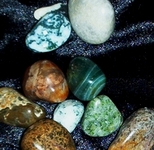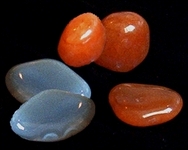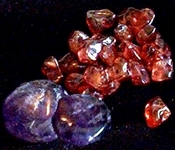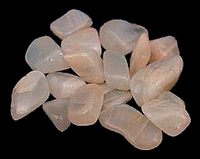Tools of the Trade - Crystal Reference
By Catherine M.
Index of Crystals:
- Agate
- Amber
- Amethyst
- Aventurine
- Bloodstone
- Calcite
- Carnelian and Chalcedony
- Clear Quartz
- Emerald
- Fluorite
- Garnet
- Hematite
- Jasper
- Jet
- Lapis Lazuli
- Moonstone
- Onyx
- Opal
- Rhodochrosite
- Tiger's Eye
- Turquoise
- Periodot
- Rose Quartz
- Sunstone
  
Agate
Agate is an oxide rock, and a member of the Quartz group. The chemical information for Quartz (SiO2) is as follows:
Formation - trigonal
Occurance - extremely common
Luster - vitreous
Diaphaneity - translucent
Density - 2.65
Hardness - 7
Cleavage - none
Fracture - conchoidal
Morphology - long to short prismatic, acicular, dipyramidal to tabular crystals, fibrous, botryoidal and stalactitic aggregates and coatings, concretions, geodes, granular, massive
|

|
Available forms for use - touchstone, pendant, jewelry, geode, cross-section, rough stone, tumbled
Cleaning - wash in fresh water, no soap. Leave out in the sun periodically
Metaphysical Cleansing and Charging - wash monthly under warm running water. Wear against the skin regularly
|
  
Amber
Amber is an organic compound. The chemical information for Amber, which is formed from a mixture of hydrocarbons, is as follows:
Formation - amorphous
Occurance - uncommon
Colour - honey-yellow, yellow-brown, brown, red-brown, blue, gree, black
Steak - white
Luster - resinous, dull
Diaphaneity - transparent to translucent, rare opaque
Density - 1.0-1.1
Hardness - 2-2.5
Cleavage - none
Fracture - conchoidal
Morphology - massive irregular or drop-shaped aggregates, nodules, fragments
|

|
Available forms for use - frough stone, touchstone, polished beads, pendant, jewelry
Cleaning - wash in fresh lukewarm water, no soa. Do not leave in sunlight as this will make it brittle.
Metaphysical Cleansing and Charging - wash in lukewarm running water when it becomes sluggish to respond - this is observable in that the amber will warm slower that usual when held.
|
  
Amethyst
Amethyst is an oxide rock, and a member of the Quartz group. The chemical information for Quartz (SiO2) is as follows:
Formation - trigonal
Occurance - extremely common
Luster - vitreous, silky, dull
Diaphaneity - transparent to translucent, opaque
Density - 2.6
Hardness - 7
Cleavage - none
Fracture - conchoidal
Morphology - long to short prismatic, acicular, dipyramidal to tabular crystals, fibrous, botryoidal and stalactitic aggregates and coatings, concretions, geodes, granular, massive
|

|
Available forms for use - touchstone, pendant, jewelry, geode, cross-section, rough stone, tumbled
Cleaning - wash in fresh water, no soap. Do not expose to sunlight to dry or charge
Metaphysical Cleansing and Charging - wash monthly under warm running water. Place amidst dry haematite. Charge by leaving out under the full moon
|
  
Aventurine
Aventurine is an oxide rock, and a member of the Quartz group. The chemical information for Quartz (SiO2) is as follows:
Formation - trigonal
Occurance - extremely common
Colour - white, light green through to dark green, dark blue
Luster - vitreous, silky, dull
Diaphaneity - transparent to translucent, opaque
Density - 2.6
Hardness - 7
Cleavage - none
Fracture - conchoidal
Morphology - long to short prismatic, acicular, dipyramidal to tabular crystals, fibrous, botryoidal and stalactitic aggregates and coatings, concretions, geodes, granular, massive
|

|
Available forms for use - touchstone, pendant, jewelry, rough stone, tumbled
Cleaning - wash in fresh lukewarm water, no soap
Metaphysical Cleansing and Charging - wash after each use in lukewarm running water. Place out in the sunlight to recharge
|
  
Bloodstone
Bloodstone is an oxide rock, and a member of the Quartz group. The chemical information for Quartz (SiO2) is as follows:
Formation - trigonal
Occurance - extremely common
Luster - vitreous, silky, dull
Diaphaneity - transparent to translucent, opaque
Density - 2.6
Hardness - 7
Cleavage - none
Fracture - conchoidal
Morphology - long to short prismatic, acicular, dipyramidal to tabular crystals, fibrous, botryoidal and stalactitic aggregates and coatings, concretions, geodes, granular, massive
|

|
Available forms for use - touchstone, pendant, jewelry, geode, cross-section, rough stone, tumbled
Cleaning - wash in fresh lukewarm water, no soap
Metaphysical Cleansing and Charging - wash after each use in lukewarm running water. Place amidst dry hematite to charge overnight
|
  
Calcite
Calcite is a member of the Carbonate group. The chemical information for Calcite (CaCo3) is as follows:
Formation - trigonal
Occurance - common
Colour - colourless, white, grey, yellow, brown, pink, red, blue, green, black
Streak - white
Luster - vitreous to pearly
Diaphaneity - transparent to opaque
Density - 2.7
Hardness - 3
Cleavage - perfect
Fracture - conchoidal
Morphology - crystals of various habit, concretations, stalactities, oolitic aggregates, granular, massive
Luminescence - sometimes red to orange
|

|
Available forms for use - tumbled stones, chunks of raw rock, polished gems, powder
Cleaning - clean under warm running water on a monthly basis
Metaphysical Cleansing and Charging - when calcite needs recharging, place overnight among rock crystals
|
  
Carnelian and Chalcedony
Carnelian and Chalcedony are almost the same rock - chalcedony however has a milky opaque quality while carnelian is translucent. They are oxide rocks, and members of the Quartz group. The chemical information for Quartz (SiO2) is as follows:
Formation - trigonal
Occurance - extremely common
Luster - vitreous, silky, dull
Diaphaneity - transparent to translucent, opaque
Density - 2.6
Hardness - 7
Cleavage - none
Fracture - conchoidal
Morphology - long to short prismatic, acicular, dipyramidal to tabular crystals, fibrous, botryoidal and stalactitic aggregates and coatings, concretions, geodes, granular, massive
|

|
Available forms for use - rough stones, tumbled stone, jewelry, touchstone, pendant, sphere
Cleaning - wash in fresh water, no soap
Metaphysical Cleansing and Charging - clean both crystals monthly under warm running water. Leave carnelian in the sun and wear it against the skin. Recharge chalcedony overnight among amethyst crystals
|
  
Clear Quartz
Quartz is an oxide rock, and a member of the Quartz group. The chemical information for Quartz (SiO2) is as follows:
Formation - trigonal
Occurance - extremely common
Luster - vitreous, silky, dull
Diaphaneity - transparent to translucent, opaque
Density - 2.6
Hardness - 7
Cleavage - none
Fracture - conchoidal
Morphology - long to short prismatic, acicular, dipyramidal to tabular crystals, fibrous, botryoidal and stalactitic aggregates and coatings, concretions, geodes, granular, massive
|

|
Available forms for use - touchstone, pendant, jewelry, geode, cross-section, rough stone, tumbled
Cleaning - wash in fresh water, no soap
Metaphysical Cleansing and Charging - wash monthly under warm running water. Place amidst dry hematite. Charge by leaving out in the sunlight
|
  
Emerald
Emerald is a silicate, and a member of the Beryl group. The chemical information for Beryl (Be3Al2Si6O18) is as follows:
Formation - hexagonal
Occurance - abundant
Colour - variable from yellow to green to blue, white, and pink
Streak - white
Luster - vitreous to dull
Diaphaneity - transparent to translucent
Density - 2.6
Hardness - 7.5-8
Cleavage - imperfect
Fracture - uneven to conchoidal
Morphology - long prismatic to tabular crystals, columnar and radial aggregates, granular, and massive
|

|
Available forms for use - touchstone, pendant, jewelry, rough stone, tumbled
Cleaning - wash in fresh water, no soap
Metaphysical Cleansing and Charging - Wash under warm running water after use. Charge by leaving out in the sunlight or in a bowl of rock crystal and/or ruby
|
  
Fluorite
Fluorite is a halide rock. The chemical information for Fluorite (CaF2) is as follows:
Formation - cubic
Occurance - extremely common
Colour - colourless through white, yellow, red, green, blue, purple, brown, and black
Luster - vitreous
Diaphaneity - transparent to translucent, opaque
Density - 3.2
Hardness - 4
Cleavage - perfect
Fracture - conchoidal to splintery
Morphology - combinations of cubic crystals, granular, and massive
|

|
Available forms for use - feldspar pieces, touchstone, pendant, jewelry, geode, rough stone, tumbled
Cleaning - wash in fresh lukewarm water, no soap
Metaphysical Cleansing and Charging - wash after each use in lukewarm running water. Place amidst rock crystal to charge overnight, or out in the sunlight
|
  
Garnet
The Garnet Group is a member of the Silicate family, and actually includes a variety of crystals - such as Pyrope, Almandine, Spessartine, Grossular, Andradite, and Uvarovite. It is formed from the ions of 2 metals - (SiO4)3 and either Mg3Al2; Fe3Al2; Mn3Al2; Ca3Al2; Ca3Fe3+2; or Ca3Cr2. The chemical information is as follows:
Formation - Cubic
Occurance - abundant (except Uvarovite which is rare)
Colour - red to purple, orange to yellow, brown to colourless, green
Streak - white
Luster - vitreous
Diaphaneity - transparent to translucent
Density - 3.4-4.3
Hardness - 6.5-7.5
Cleavage - none
Fracture - B conchoidal to uneven
Morphology - isometric crystals, granular
|

|
Available forms for use - rough stone, jewelry, tumbled stone, cut stone
Cleaning - wash in warm running water, no soap
Metaphysical Cleansing and Charging - Skin contact is important in cleansing and charging garnets. Place in the sun to recharge
|
  
Hematite
Hematite is an Iron Oxide, and a member of the Oxide group. The chemical information for Hematite (Fe2O3) is as follows:
Formation - trigonal
Occurance - common
Colour - red, grey, and black
Streak - red
Luster - metallic or dull
Diaphaneity - opaque
Density - 5.3
Hardness - 5.5-6.5
Cleavage - none
Fracture - Conchoidal, uneven, splintered
Morphology - thick to thin tabular crystals, massive, earthy
|

|
Available forms for use - rough stones, cut and polished amulets, tumbled stones, jewelry
Cleaning - Do not clean in water
Metaphysical Cleansing and Charging - Rest in a pile of rock crystals where the hematite will release any gathered negative energy and recharge
|
  
Jasper
Jasper is an oxide rock, and a member of the Quartz group. The chemical information for Quartz (SiO2) is as follows:
Formation - trigonal
Occurance - extremely common
Luster - vitreous, silky, dull
Diaphaneity - transparent to translucent, opaque
Density - 2.6
Hardness - 7
Cleavage - none
Fracture - conchoidal
Morphology - long to short prismatic, acicular, dipyramidal to tabular crystals, fibrous, botryoidal and stalactitic aggregates and coatings, concretions, geodes, granular, massive
|

|
Available forms for use - touchstone, pendant, jewelry, geode, cross-section, rough stone, tumbled
Cleaning - wash in fresh lukewarm water, no soap
Metaphysical Cleansing and Charging - wash after each use in lukewarm running water. Place amidst dry hematite to charge overnight
|
  
Jet
Jet is an organic material - petrified coal. The chemical information for Jet (C) is as follows:
Formation - amorphous
Occurance - common
Colour - black, opaque
Streak - brown
Luster - velvety, waxy
Diaphaneity - opaque
Density - 1.19-1.35
Hardness - 2.5-4
Fracture - conchoidal
|

|
Available forms for use - touchstone, pendant, jewelry, rough stone, tumbled
Cleaning - never place in water or leave in the sun. Use a soft cloth to polish it
Metaphysical Cleansing and Charging - This takes two nights - one night in salt, the second in rock crystals
|
  
Lapis Lazuli
Lapis Lazuli is rock, not a mineral, fomed by the combination of four minerals (Hauynite, Sodalite, Noselite, and Lazulite). The chemical information for Lapis Lazuli ( (Na,Ca)8[(S,SO4,Cl2)2/(AISiO4)6]+Fe ) is as follows:
Colour - light greenish blue through to dark purple blue, often with flecks of pyrite
Diaphaneity - opaque
Hardness - 5.5
Morphology - as a sodium-silicate-aluminium composite, Lapis doesn't tend to form crystals
|

|
Available forms for use - rough stone, jewelry, tumbled stone, cut stone
Cleaning - use a soft cloth - DO NOT WASH as water can dissolve the stone
Metaphysical Cleansing and Charging - Monthly, place the stones in a bowl with haematite overnight and then recharge among rock crystal
|
  
Moonstone
Moonstone is a silicate rock and a member of the Orthoclase Feldspar group. The chemical information for Feldspar (KAISi3O8) is as follows:
Formation - monoclinic
Occurance - extremely common
Color - colorless, white, yellowish, pinkish, grey, brown
Streak - white
Luster - vitreous to pearly
Diaphaneity - transparent to translucent
Density - 2.5
Hardness - 6 - 6.5
Cleavage - good
Fracture - uneven to conchoidal
Morphology - prismatic and tabular crystals and their combinations, granular, massive
|

|
Available forms for use - always cut to bring out the sheen, jewelry, amulet, tumbled
Cleaning - wash in fresh water, no soap
Metaphysical Cleansing and Charging - place amidst dry haematite - if you are female, cleanse it after menstruation. Charge by leaving out under the full moon
|
  
Onyx
Onyx are oxide rocks, and members of the Quartz group. The chemical information for Quartz (SiO2) is as follows:
Formation - trigonal
Occurance - extremely common
Luster - vitreous
Diaphaneity - translucent
Density - 2.65
Hardness - 7
Cleavage - none
Fracture - conchoidal
Morphology - long to short prismatic, acicular, dipyramidal to tabular crystals, fibrous, botryoidal and stalactitic aggregates and coatings, concretions, geodes, granular, massive
|

|
Available forms for use - rough stones, tumbled stone, jewelry, touchstone, pendant
Cleaning - wash in fresh water, no soap
Metaphysical Cleansing and Charging - discharge the crystal weekly under fresh running water. Burying during the dark of the moon will help recharge it
|
  
Opal
Opal is an oxide rock. The chemical information for Opal (SiO2.nH2O) is as follows:
Formation - amorphous
Occurance - extremely common
Colour - colourless, white, red, iridescence, brown, yellow, green, grey, blue
Steak - white
Luster - vitreous, dull, earthy, waxy
Diaphaneity - transparent to translucent, opaque
Density - 2.1
Hardness - 5.5-6.5
Cleavage - none
Fracture - conchoidal
Morphology - botryoidal and stalactite aggregates, coatings, concretions, geodes, massive
|

|
Available forms for use - touchstone, pendant, jewelry, rough stone, tumbled, chips
Cleaning - soak often in water for 30 minutes, no soap. Soap, make-up, lotions, and perfume remove the sparkle of opal, so cleanse regularly. Some people recommend never using opal with other crystals, but I have always found opal to be a good companion stone. Do not leave in the sun
Metaphysical Cleansing and Charging - recharge in rock crystals
|
  
Periodot
Periodot is a member of the Olivine family of minerals. The chemical information for Periodot (Mg2SiO4, Fe2SiO4) is as follows:
Formation - orthorhombic
Occurance - common
Colour - yellowish-green
Streak - white
Luster - vitreous
Diaphaneity - translucent to transparent
Density - 3.3
Hardness - 6.5-7
Fracture - conchoidal
|

|
Available forms for use - gem, pendant, jewelry, rough stone, tumbled, chips
Cleaning - wash in fresh water, no soap.
Metaphysical Cleansing and Charging - discharge under running water daily when using. Recharge in the sun for a few hours.
|
  
Rhodochrosite
Rhodochrosite is a member of the Carbonates. The chemical information for Rhodochrosite (MnCO3) is as follows:
Formation - trigonal
Occurance - abundant
Colour - white, pink, red, brown
Streak - white
Luster - vitreous
Diaphaneity - transparent to translucent
Density - 3.6
Hardness - 3.5-4
Cleavage - perfect
Fracture - conchoidal to uneven
Morphology - rhombohedral and scalenohedral crystals, hemispherical and botryoidal aggregates, granular, massive
|

|
Available forms for use - polished, tumbled rocks, jewelry, rough stone, touchstones
Cleaning - wash in fresh water, no soap. Do not expose to sunlight to dry or charge
Metaphysical Cleansing and Charging - always discharge after use in running water. Use rock crystals to charge. Wear it if it starts to discolour as your own energy will recharge and cleanse it
|
  
Rose Quartz
Rose Quartz is an oxide rock, and a member of the Quartz group. The chemical information for Quartz (SiO2) is as follows:
Formation - trigonal
Occurance - extremely common
Luster - vitreous
Diaphaneity - translucent
Density - 2.65
Hardness - 7
Cleavage - none
Fracture - conchoidal
Morphology - long to short prismatic, acicular, dipyramidal to tabular crystals, fibrous, botryoidal and stalactitic aggregates and coatings, concretions, geodes, granular, massive
|

|
Available forms for use - touchstone, pendant, jewelry, geode, cross-section, rough stone, tumbled
Cleaning - wash in fresh water, no soap.
Metaphysical Cleansing and Charging - wash monthly under warm running water or leave amongst hematite. Recharge overnight with amethyst.
|
  
Sunstone
Sunstone is one of the feldspar group of minerals. The chemical information for Sunstone (NaAlSi3O8 - CaAli2Si2O8) is as follows:
Formation - triclinic although rarely seen as crystals
Occurance - common
Colour - white, yellow, orange, pink, or brown with a reddish or golden sheen
Steak - white
Luster - vitreous
Diaphaneity - opaque
Density - 2.6
Hardness - 6-6.5
Cleavage - good
Fracture - uneven to conchoidal
Morphology - tabular crystals, platy aggregates, granular, massive
|

|
Available forms for use - touchstone, pendant, jewelry, rough stone, tumbled, chips
Cleaning - wash in fresh lukewarm water, no soap.
Metaphysical Cleansing and Charging - wash monthly under warm running water and recharge in sunlight for a few hours.
|
  
Tiger's Eye
Tiger's Eye is an oxide rock, and a member of the Quartz group. The chemical information for Quartz (SiO2) is as follows:
Formation - trigonal
Occurance - extremely common
Luster - vitreous, silky, dull
Diaphaneity - transparent to translucent, opaque
Density - 2.6
Hardness - 7
Cleavage - none
Fracture - conchoidal
Morphology - long to short prismatic, acicular, dipyramidal to tabular crystals, fibrous, botryoidal and stalactitic aggregates and coatings, concretions, geodes, granular, massive
|

|
Available forms for use - touchstone, pendant, jewelry, geode, cross-section, rough stone, tumbled
Cleaning - wash in fresh water, no soap
Metaphysical Cleansing and Charging - only wear for a few days at a time. Wash under warm running water after use. Charge by leaving out in the sunlight
|
  
Turquoise
Turquoise is a phosphate rock. The chemical information for Turquoise (CuAI6(PO4)4(OH)8.4 H2O) is as follows:
Formation - triclinic
Occurance - uncommon
Color - blue, blue-green, green
Streak - white
Luster - waxy
Diaphaneity - transparent, translucent to opaque
Density - 2.9
Hardness - 5 - 6
Cleavage - good
Fracture - uneven to conchoidal
Morphology - short prismatic crystals, botryoidal aggregates, coatings, massive
|

|
Available forms for use - touchstone, pendant, jewelry, geode, cross-section, rough stone, tumbled
Cleaning - wash in fresh water, no soap. Do not expose to sunlight to dry or charge
Metaphysical Cleansing and Charging - wash monthly under warm running water. Place amidst dry haematite. Charge by leaving overnight in a bowl of rock crystals
|
  
Return to the Index of articles for Tools of the Trade
Main Index of Articles
  
Magazine Archive Page
|





















